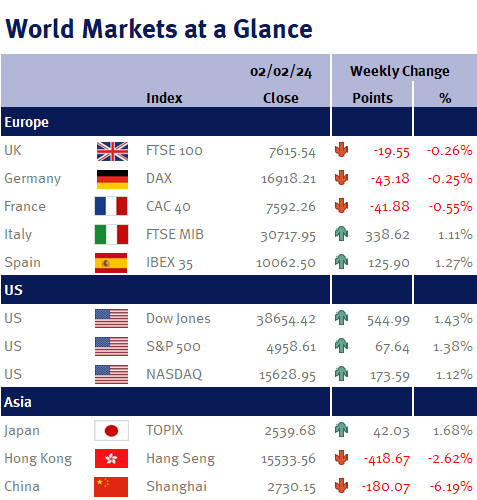US labour market data on Friday revealed nonfarm payrolls surged by 353,000, surpassing expectations and highlighting the robustness of the job market. The unemployment rate remained steady at 3.7%. Hourly wages experienced notable growth compared to the previous month, marking the highest increase since March 2022. Additionally, separate data indicated a significant rise in US consumer sentiment. Market closed the week on a high note following positive signals from big tech companies and the labour market appears to be holding up well. These solid data points are likely to push the Federal Reserve to hold off anticipated rate cuts.
The Bank of England (BoE) opted to keep its key Bank Rate robust at 5.25%, aligning with predictions. Behind closed doors, a nuanced scenario emerges, revealing a split vote: two hawkish policymakers advocate for a 25bps hike, while one dovish voice calls for a reduction. Despite this divergence, the collective stance maintains a restrictive approach to anchor inflation toward the 2% target. The subtle departure from signalling further tightening suggests a potential shift in policy direction, as the central bank balances the dual goals of curbing inflation and fostering growth. Encouraging signs include cooler service sector inflation and a dip in wage growth, indicating the positive impact of previous rate hikes. The BoE’s strategy highlights the delicate balance between stimulating economic health and ensuring price stability. Governor Andrew Bailey emphasises the need for confidence in inflation returning to the 2% target before considering interest rate cuts, despite market expectations of multiple cuts this year.
The Caixin China General Manufacturing PMI signals ongoing resilience in China’s manufacturing sector as we enter 2024. Despite global uncertainties, the index holds steady at 50.8 for January, consistent with December and slightly surpassing market expectations. This marks the third consecutive month of factory activity expansion, providing a positive contrast to official data indicating a prolonged soft patch as we approach Lunar New Year celebrations.
In January 2024, the Eurozone experienced a slight year-on-year decrease in the inflation rate, dropping from 2.9% to 2.8%. The core rate, excluding volatile food and energy prices, also showed a decline to 3.3%, slightly above forecasts at 3.2% but the lowest since March 2022. This easing may prompt central banks to reassess interest rates.
Despite challenging conditions, Ireland’s Manufacturing PMI exhibits resilience, edging up to 49.5 in January 2024 from 48.9 the previous month. This increase reflects growth in output, export orders, and employment levels, highlighting the adaptability of Irish manufacturers.
Looking ahead, next week brings PMI services data from the UK, Europe, and the US, along with European retail sales and China’s inflation rate for January.
Kate Mimnagh, Portfolio Economist



